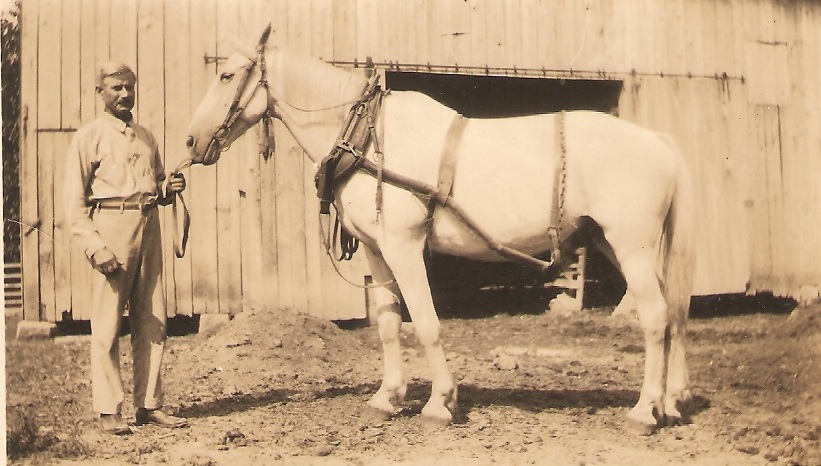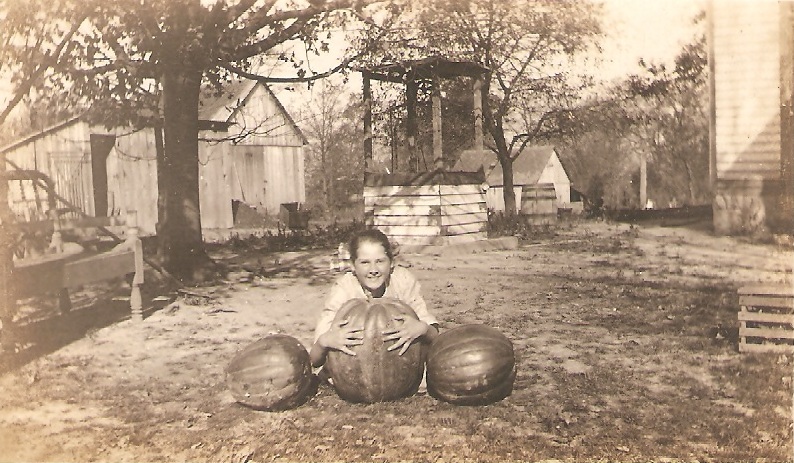The HORSE DRAWN Papers #1
C O L U M B U S B U G G Y W O R K S
My great-grandfather was born Hermann Heinrich Müller. Hermann was a first-generation American, born just two years after his parents and older siblings left Germany and settled in north Knox County, near Vincennes, Indiana. This modest farm was bought out by a coal company to strip mine and Hermann, who by now, had Anglicized his name to Herman Henry Miller, married into a prominent Edwardsport family, the Reeves. Herman and his wife settled on a farm in the area. Here they raised their daughter and her children. In the early 1900s, Herman needed a new wagon.
Herman Miller and Rallie in front of the old barn, Bicknell, Indiana, about 1940.
Shortly before 1870, entrepreneur Clinton Firestone of Firestone Tire and Rubber Company fame and family associated himself with George and Oscar Peters, two men who had worked in the leather business. These brothers had developed a method for building wagons for under $200 each. With a wealth of resources and the wealth of cash Firestone could provide, the three formed eventually the Columbus Buggy Works. Ultimately, Eddie Rickenbacker would become associated wiith the automotive side of the business.
The brothers had already made and sold about 100 buggies using wood sawn from around the Ohio Penitentiary - speculatively Ash. They used their new manufacturing process. In 1870, the newly formed Iron Buggy, as Firestone and the Peters named it, and opened their business in what Wikipedia has termed "a shanty" at 180 North High Street in Columbus, Ohio. This location is now in the "Short North" or "Arena District." Placing a buggy factory in this area was a good idea. Iron Buggy sold 274 wagons in the first year. It was a good idea until it burnt down on May 27, 1874. Then it became better.
The business was rebuilt and sold to a Mr. Tuller, proprietor of the Buckeye Buggy Company. Firestone and the Peter brothers then took the proceeds of the sale and formed two companies: the Columbus Buggy Company and the Peters Dash Company. These businesses opened on Wall and Locust Streets closer to the railroad freight house. They came with a line of wagons at several price points as well as add-ons like dashboards, fenders, and so on. These companies were completely successful and profitable. But success does not come without price.
The Timken Roller Bearing Axle Company incorporated in St. Louis in 1899. But the founder, Heinrich (Henry) Timken had been in the spring and suspension business for much longer. In 1883, Timken filed a $50,000 lawsuit against Firestone and the Peters for patent infringement involving a spring design patented by Timken and used by the Columbus Buggy Company. Somehow, Studebaker became involved as a litigant and after a long-drawn-out lawsuit, the judgement was against the Columbus Buggy Company for $3,000. During the process, Firestone and Timken became friends.
Meanwhile, the Columbus Buggy Company grew so that by 1888, its facilities took in an entire city block on Spring Street between High and Wall Streets. In was the largest buggy producer and began advertising in magazines. By 1892, the Columbus Buggy employed 1200 workers who produced 100 buggies per day. The company even had a presence at the 1893 Chicago World's Fair and advertised dealerships in all states. Just a few years later, it is claimed that one of every six wagons on the road were built by the Columbus Buggy Company.
So, what did Gran'pa Miller get for his money?
I am indebted to Dave and Diane Engles of Engel Coach Shop as well as Rick Bischoff of The Luminary Shoppe to providing both technical and creative direction through their YouTube contributions. Rick repairs, restores, and replicates oil and candle lanterns used on wagons and coaches in the era. Some of his work has been available in nearby Millersburg. Dave is a qualified wainwright and wheelwright, famous for his reproduction of the 20-Mule-Team Borax Wagons and has also restored a two-seat wagon. Today, we might interpret a two-seater as a left and right bucket seat in a sports car, but in those days a two-seater meant front and back bench seats, much like a modern four-door town car. Then, for comfort over unimproved roads, springs were added. With this wagon, Gran'pa Miller could take his wife and daughter to all-day church service at the Mariah Creek Baptist Church with room for a picnic basket, blankets, and possibly some chairs or other supplies they might need. Thanks to Dave Engels, I can envision Herman Millers trusty horse and wagon hitched to a rail and two proud parents watching their daughter play in the rich shade grass under cool, leafy trees, with Mariah Creek babbling in the background. This is a day that memories are made of. I would also invite everyone to check out Dave Engel's enormous video library on YouTube at Engels Coach Shop as well as the Luminary Shoppe on YouTube to learn more about the Horse-and-Buggy Days.
Herman's daughter and her pumpkins on the Miller farm.
With the advent of the horseless carriage, the Columbus Buggy Company would try to enter the fledgling automotive industry and shortly failed. Dave and Rick have more business than anticipated. Herman's daughter would learn to drive the buggy, and please don't tell anyone, Gran'pa Miller taught his daughter to drive a car. (Women weren't allowed back then.) Gran'pa Miller would turn his farm over to his son-in-law who, in turn, bought a tractor. For the Millers, the Horse-Drawn Era was over.
Herman, his daughter, and an unknown Miller cousin meet the farm wagon coming home.




No comments:
Post a Comment